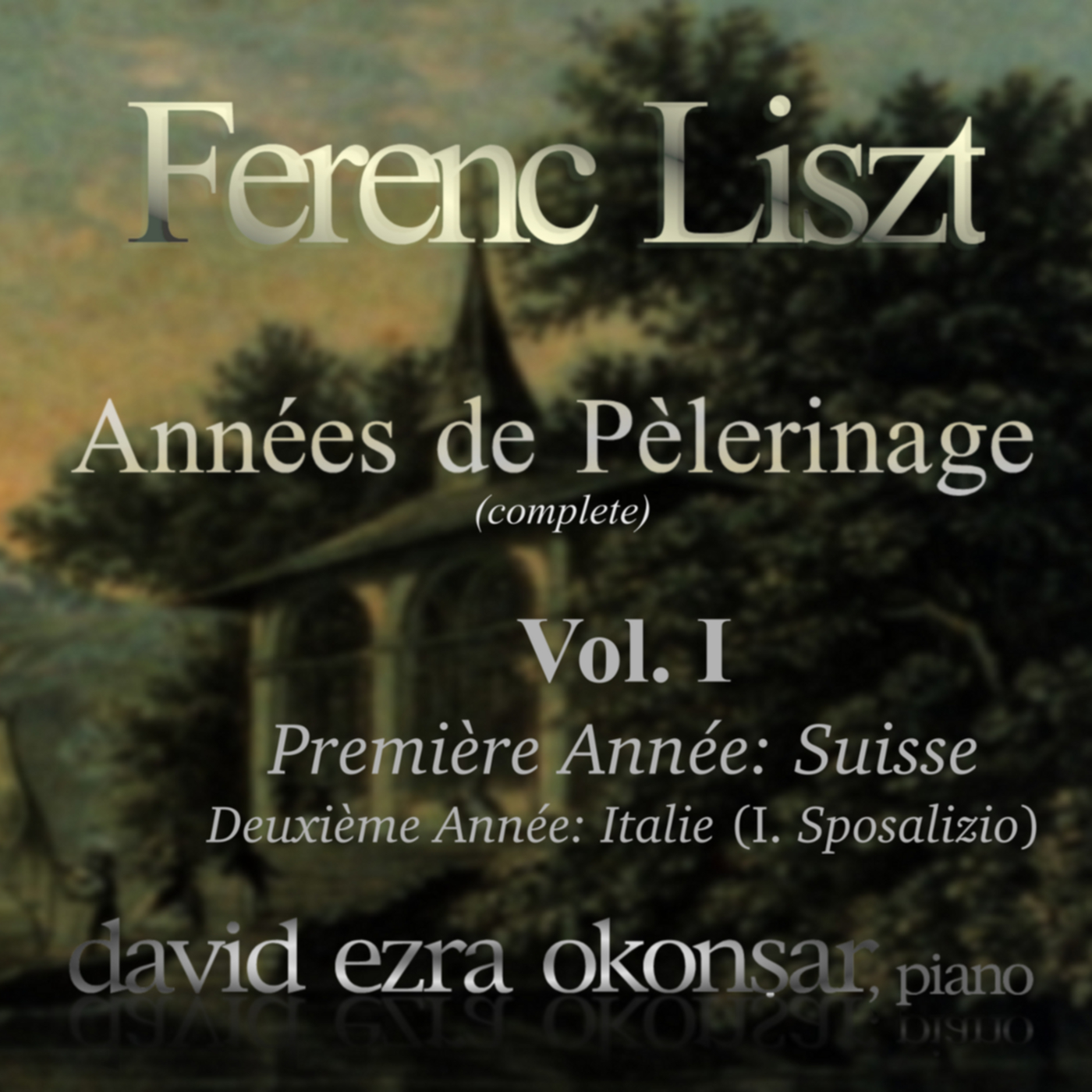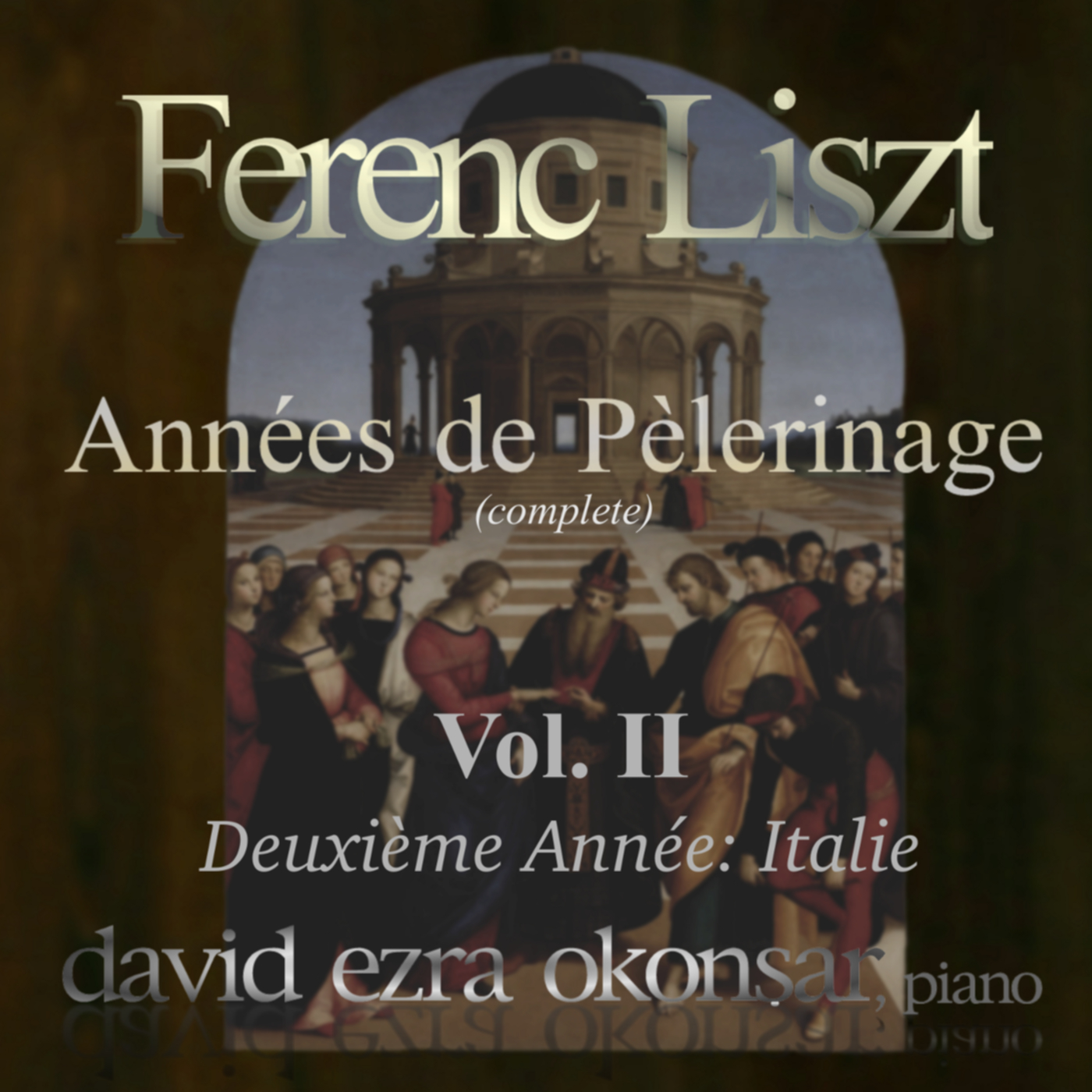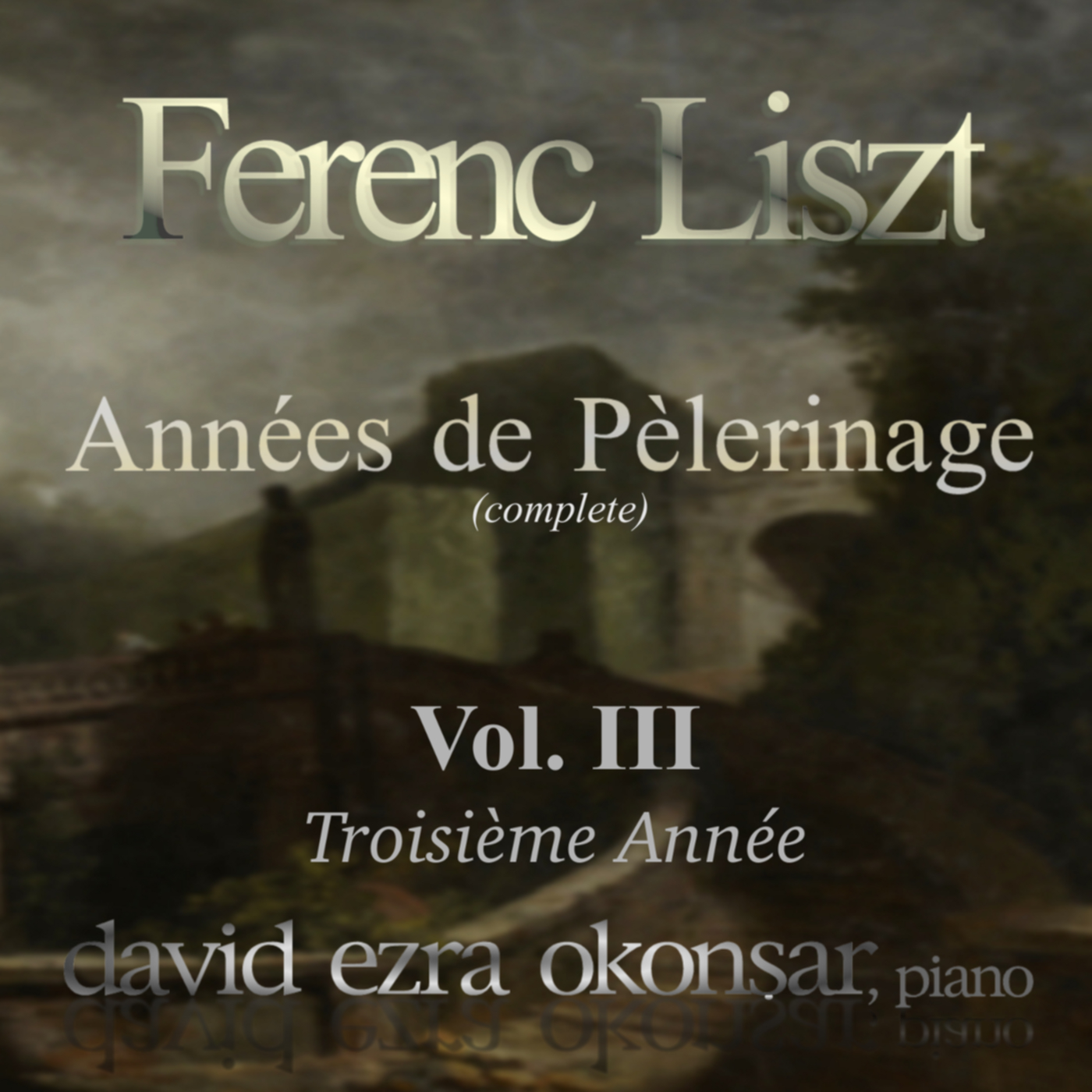Ferenc Liszt
3 CD set



|
Liszt created the modern piano technique. Camille Saint Saens states: ".. unlike Beethoven, who did not count on the specific morphology of the hand and imposed to them his tyrannic musical will, Liszt trained them in their proper natural formation to obtain the maximum. Thus, his music, which looks frightening at first, is actually less difficult than it appears." Liszt also created a revolutionary piano sound in the history. He was not a revolutionary composer but he made the piano like a new instrument. This "new" instrument emerges from a revolutionary musical écriture with themes in block-chords, double octave runs, fascinating left hand deep bass tremolos or very high-pitched chord tremolos thus featuring many large orchestral effects. Bewildering fast jumps, infuriating arpeggios and many more. Yes, this is bright virtuosity but virtuosity for its own sake becomes rapidly boring. One thinks of Sigismund Thalberg, a great virtuoso player in its time, who has cultivated virtuosity for itself in charming but annoying "salon" pieces. Who plays Thalberg now? Claude Rostand said it first: "this is not pianistic technique for itself but in the service of music." The piano as an instrument got to its definitive form as we know it today, around 1850. That is midway through Liszt's creative life. Extended spiraled bass strings with deep and powerful sonorities, a large body and gigantic resonance volume (as compared to previous instruments) and the keyboard span in its final 88 keys appeared only then. Liszt did foresee that fabulous instrument in his previous works and once it was physically available, he used it to create truly orchestral music at the keyboard. He did not hesitate to use three (in Mazeppa) or even four staves (in Sonetto 47 of Petrarca) to layout his orchestral vision of music. The pedal became an impressionistic tool, deep and profound basses were used for the first time for their specific sound effect, both thumbs performing a melody in alternation while other fingers are embroidering arpeggios around it, and many other novelties are created by Liszt and used in the centuries to come. The huge pianistic output of Liszt is very difficult to classify. It is not presented clearly labeled and organized. Often boundaries between different genres are blurred. So one Etude can be considered as a poetic piece while a Hungarian Rhapsody can be seen as programme-music. The Pilgrimage Years (Années de Pèlerinage) In the preface to the publication of the first year of Pilgrimages (Switzerland) the composer writes: "having traveled in those years many new countries, many diverse sites, many localities with strong ties with history and poetry; having felt that the diverse aspects of the nature and to the events connected with them were not parading before my eyes as simple images but they were, instead, creating profound feelings in my soul [..] I attempted to render with music some of the strongest feelings, my longest lasting perceptions." The full set is made of 26 pieces in three books and its composition took approximately 40 years. A sort of musical diary reporting and sublimating impacts from nature, works of art (poetry and paintings), religious and mystical feelings. Started in 1836, it includes parts from an early composition set titled Album d'un voyageur (A traveler's album), the first book, Switzerland was only published in 1855. Its nine pieces evoke the stay and various excursions he did with Marie d'Agoult. Composed between 1837 and 1849, published in 1858, the second book "Italy" (Deuxième année) was also inspired from a trip with Marie d'Agoult. However, those seven pieces reveal a noticeable evolution in the musical thinking of Liszt. He seems to withdraw inspiration more from literature (Dante, Petrarca), painting (Rafaello) and sculpting (Michelangelo). There are attempts to create parallels between arts (symmetrical figures in Sposalizio) and a sort of premonition of what Wagner was going to idealize. To this second year of pilgrimage was added, years later a series of charming pieces "Venezia e Napoli". Composed much later than the previous ones, the third year's book includes seven pieces composed in 1867, 1872 and 1877. The book was published in 1883, three years before the death of the composer. One witnesses a new aspect of the musical genius of Franz Liszt who formally joined the ecclesiastic ranks by being enthroned in 1865. A religious serenity emerges in this music. Finally, this large corpus is a journey of a romantic artist, best described by Guy Ferchault: "Grandeur above all. Liszt seeks for it in his passionate love affairs, in his art, but finally get it only in the austerity which leads closer to G-d. It is that bewildering journey which makes the essence of the Années de Pèlerinage. It is a travel book of a romantic artist in his quest for the Absolute, following a mystical meaning he gets in art. None other of his works, no matter how awesome they are, can be compared to that." "Suisse" (Première Année) S.160 (First Year: Switzerland) Chapelle de Guillaume Tell (Lento - Più lento - Allegro vivace) A musical portrait of the Helvetic hero, Schiller's well-known motto "one for all, all for one" is an epigraph to the piece. The Chapelle de Guillaume Tell is one anthem like piece which develops into an exceptionally wide dynamic range towards the end where the theme is restated in full power with broken chords accompaniment. The middle section features tremolo seventh chords which makes the background for heroic "trumpet calls". Thereafter the calls for insurrection metamorphose into a glorious choral chant. Au lac de Wallenstadt (Andante placido) Also featuring an epigraph, this time from Lord Byron's Childe Harold: .. thy
contrasted lake,
With the wide world I dwell in, is a thing Which warms me, with its stillness, to forsake Earth's troubled waters for a purer spring. This is a beautifully calm and lyrical piece. There is an undeniable intention of descriptive even imitative settings throughout this nocturne-like piece. Marie d'Agoult wrote in her memories that Liszt wished to evoke the breath of the waters as well as the pace of the oars. Without a doubt, the typical rhythm of the left hand figuring a triplet followed by four sixteenth notes evokes that kind of image. The pastorale-like melody features number of fourth and fifth intervals. Approaching the end, this melody melts into a haze with the right hand arpeggios. Pastorale (Vivace) Fête villageoise (Villager Feast) was the initial title of this very short number. A naive figuration of a country style chant in the bright key of E major. Au bord d'une source (Allegretto grazioso) Again Schiller is quoted on epigraph: "In a whispering freshness begin the merriments of the young nature". An exquisite reverie in a delicate harmonic texture. The "freshness" and the "whispering" of the nature is suggested right from the beginning by the figurations at the right hand with spiky dissonances. One unique theme throughout the piece describes the glimmering sight of the waters. Orage (Allegro molto - Presto furioso - Meno allegro - Più molto) No longer than the previous one, this piece however figures a wide number of sections. It evokes both a natural storm and its corresponding state of mind. Full varied pianistic and virtuoso effects abound like grandiose "furies of octaves" and swarming gusts of wild chromaticism. Vallée d'Obermann (Lento assai - Più lento - Recitativo - Più mosso - Presto - Lento) The longest and most developed piece of the series. A full length quote opens the score. It is from the French writer Étienne Pivert de Senancour's (1770-1846) autobiographic novel "Obermann". A portrait of a solitary man characterized somewhat between Rousseau and Werther by Goethe. This novel was very well-known since its publication in 1804. Liszt dedicated the piece to Sénancour who died in 1846. The quote starts with "Who am I?". A bitter and disillusioned questioning marvellously rendered by the free-form recitativo-like introduction to the piece. The piano-poem is of grand pathetic eloquence with audacious harmonic novelties. Poignant dissonances, far-fetched modulations, with a tumultuous middle section (Presto) which will lead to a rather optimistic reprise of the main theme, a sort of conquest of oneself. Nevertheless, the concluding bars seem desperate. Églogue (Allegretto con moto) "Eclogue" is a pastoral poem presented with a long quote from Étienne Pivert de Senancour: "De l'expression romantique et du ranz-des-vaches" from Oberman again. It is a charming and delightful music-poem which seems adequately fitted as a postlude to the Vallée d'Obermann. "Ranz des vaches" is a melody sung by Swiss herdsmen or played on the horn to call cattle to or from the pasture. One can hear the flute of a shepherd melting into a joyful song and reappearing at the end while fading away. Le mal du pays (Lento - Adagio dolente - Lento - Andantino - Adagio dolente - Più lento) Many different tempo settings for this small piece which deserves to be better known. Its many sections together create a free improvisational mood. It is a lyrico-dramatic scene displaying themes from two previous compositions: N.2 "Fleurs des Alpes" from "Album d'un voyageur" (1835) and "Fantaise Romantique". One of those themes, which opens the piece and is exhibited with its "echo" is "Ranz des vaches". In 1767, the "Dictionnaire de Musique" by Jean-Jacques Rousseau claims that Swiss mercenaries were threatened with severe punishment to prevent them from singing their Swiss songs, including the "Ranz des vaches". There is a romantic connection of nostalgia between the Kuhreihen (Ranz des vaches) and the Swiss Alps. Les cloches de Genève: Nocturne (Quasi allegretto - Cantabile con moto - Animato - Più lento) This Nocturne is dedicated to Liszt's first born daughter Blandine, born in 1835 in Switzerland. Byron, again is quoted in epigraph: I live
not in myself, but I become
Portion of that around me. Over soft and remote ringing of bells develops a tender melody. Bells ringing from a very low range seem to respond to the previously heard ones while the melody repeats as a lullaby. An animated middle section appears as a hymn to life. "Italie" (Deuxième Année) S.161 (Second Year: Italy) Sposalizio (Andante - Andante quieto - Più lento - Quasi allegretto mosso - Adagio) The overall perfect symmetry of this painting from Rafaello ("Le Mariage de la Vierge", 1504) which is in the Brera Palace of Milan, as well as the sacred vision of the painter can be traced in the purity of form of this lyrical piece. A bells-like motive opens the piece, this near pentatonic figure will be used at the coda as well. The ethereal harmonies of the Andante quieto reflects the delicacies of the Quattrocento painting, a warm light is all over the figures, just as in the painting. A prudish modesty and humility echoes on every musical gesture. Il penseroso (Lento) A Michelangelo sculpture located at the grave of Julien de Medicis in Firenze, at the church San Lorenzo is the inspiration for this second piece of the series. The music represents admirably the melancholy of the "thinker" with dark chords and profound dissonances. Sounding bare fifths are like mirroring the coldness of the marble and the chromatic dive in the coda with dissonances in a held pedal create a unique atmosphere. This piece had a particular meaning for the composer. Later he made a larger orchestral version of it, named La Notte, from another sculpture of Michelangelo in the Canzonetta del Salvator Rosa (Andante marziale) This canzonetta is a faithfully transcribed popular Italian march-song. The original song's lyrics are commonly attributed to the Neapolitan painter and adventurer of the seventieth century Salvator Rosa (1615-1673) "Vado ben spesso cangiando loco": Rather
often go I
changing place; but unable am I to change my desire. Always the same my fire will be; and always the same I will be myself. Rather often go I changing place; but unable am I to change my desire. The main melody, however, is not from Rosa, but from Giovanni Battista Bononcini (1670-1747) an Italian baroque opera composer. A charming and naive piece. Sonetto 47 del Petrarca (Preludio con moto - Ritenuto - Sempre mosso con intimo sentimento) The three Petrarca Sonnets are initially composed in 1838-39 as lieds for high tenor and piano, then Liszt transcribed them for piano solo, approximately at the same time. But shortly before 1858, the composer rewrote them, giving the final version as we know today. Towards 1865 he even did yet another version for baritone voice and piano. The vocal versions are far below the level of lyricism and the richness of creativity shown in the piano solo versions which are among the greatest pieces of the romantic repertoire. The Sonnet 47 is immersed in sheer ecstasy, the melody gently settles over a lute-like accompaniment of the left hand. Blessed
be the day, and the month, and the year,
and the season, and the time, and the hour, and the moment, and the beautiful country, and the place where I was joined to the two beautiful eyes that have bound me: and blessed be the first sweet suffering that I felt in being conjoined with Love, and the bow, and the shafts with which I was pierced, and the wounds that run to the depths of my heart. Blessed be all those verses I scattered calling out the name of my lady, and the sighs, and the tears, and the passion: and blessed be all the sheets where I acquire fame, and my thoughts, that are only of her, that no one else has part of. Sonetto 104 del Petrarca (Agitato assai - Adagio) This musical poem, again starts with a prelude climbing with pain to a climax where the recitative is of a sustained vehemence. "Pace non trovo" (I find no peace), the principal theme in E major is spasmodic, often broken its lyrical momentum. It alternates between enthusiasm ("vibrato, con esultazione") and most poignant sadness ("languido, dolce dolente"). At the end, all appease in a sigh of reconciliation with a more serene passion. I find no
peace, and yet I make no war:
and fear, and hope: and burn, and I am ice: and fly above the sky, and fall to earth, and clutch at nothing, and embrace the world. One imprisons me, who neither frees nor jails me, nor keeps me to herself nor slips the noose: and Love does not destroy me, and does not loose me, wishes me not to live, but does not remove my bar. I see without eyes, and have no tongue, but cry: and long to perish, yet I beg for aid: and hold myself in hate, and love another. I feed on sadness, laughing weep: death and life displease me equally: and I am in this state, lady, because of you. Sonetto 123 del Petrarca (Lento placido - Sempre lento - Più lento) This piece is a contemplative love dream with a confident fulfillment. The main melody is wrapped with an infinite tenderness, it does, however leads to a dramatic surge. Yet, at the end of each passionate impetus it appears with even more lovingness, often sustained with most tender harp-like chords. I saw
angelic virtue on earth
and heavenly beauty on terrestrial soil, so I am sad and joyful at the memory, and what I see seems dream, shadows, smoke: and I saw two lovely eyes that wept, that made the sun a thousand times jealous: and I heard words emerge among sighs that made the mountains move, and halted rivers. Love, Judgement, Pity, Worth and Grief, made a sweeter chorus of weeping than any other heard beneath the moon: and heaven so intent upon the harmony no leaf was seen to move on the boughs, so filled with sweetness were the wind and air. Après une lecture de Dante: Fantasia Quasi Sonata Also called "Dante-Sonata", this is the longest and last piece of the series. The title is from a poem by Victor Hugo, however, we know that Liszt was reading intensively the Divina Commedia in Italy where he was with Marie d'Agoult. A first draft was titled: "Paralipomènes à la Divina Commedia, Fantaisie Symphonique" in 1837. Liszt premiered the piece in Vienna in 1839, then he revised it the next year. The work got its final form in 1849. The Inferno of Dante is depicted here with its "terrible tongues, horrific screams, roars of pain". In one single movement, the "Dante-Sonata" is also a deep reflection between the sonata form and the cyclic one with the use of leitmotives. Venezia e Napoli: As a supplement to the book of Second Year of Pilgrimage, Liszt included this series of three pieces from popular inspiration. Originally, in 1838 there were four pieces, the first one was then removed but included in the symphonic poem Tasso. The three pieces of the final version of 1859, published in 1861, are, regarding the first and third ones, rewritings of the initial first and fourth pieces. Compared to the earlier version, the final writing is more fluid, richer and more elegant. Gondoliera (Quasi allegretto) Based on the song "La biondina in Gondoletta" by Cavaliere Perucchini the Gondoliera is an amiable piece with a notable ending figuring a perfect compositional elaboration of a fade-out effect. Canzone (Lento doloroso) "Nessun maggior dolore" from Otello by Rossini is the source of this piece, elaborated simply but effectively on tremolos at the left hand all over it. It connects to the last number. Tarantella (Presto - Più vivace - Canzone Napoletana - Prestissimo) The longest piece of the series mostly based on an interplay between major and minor keys of G. The theme is from Louis Cottrau (1797-1847), French composer and music publisher. The dance figures are around a central movement featuring a Neapolitan song (Canzone Napoletana) ornamented with brilliant arabesques. Troisième Année S.163 (Third Year) Angélus! (Andante pietoso) Composed in 1877, it is dedicated to the gran-daughter of Liszt: Daniela von Bülow, it was first written for string quartet. A religious and somewhat naive composition of great charm with an alluring rendition of Angelus bells. Aux cyprès de la Villa d'Este I: Thrénodie (Andante - Più agitato - Tempo I) Aux cyprès de la Villa d'Este II: Thrénodie (Andante non troppo lento - Un poco animato - Tempo I - Un poco animato - Tempo I - Più lento) A threnody is a lament or elegy composed or performed as a memorial to a dead person. Both pieces, from 1877, are nostalgic regrets depicting the gigantic cypress of the Villa d'Este in Tivoli where Liszt stayed several times, from 1864, thanks to the generosity of his friend the Cardinal Hohenlohe. It seems that the second threnody was inspired by the cypress of the church Santa Maria degli Angeli, said to be planted by Michelangelo himself. The threnodies, tragic and dramatic pieces, feature a deep and elaborated harmonic craft, highly chromatic with many whole-tone passages as well. Les jeux d'eaux à la Villa d'Este (Allegretto - Un poco più moderato - Un poco accelerando - Un poco più lento) Best known piece of the series, everyone is aware how this marvelous impressionistic work prefigured the Jeux d'Eaux of Maurice Ravel (1901). The many cascades, water jets, littles caverns are all in it but most importantly this is not an alluring scherzo but again a deep meditative piece which leads to a section with an Evangelic (from St. John Passion) inscription: "ad vitam aeternam": "but
whoever drinks the water I give them will never thirst. Indeed, the
water I give them will become in them a spring of water welling up to
eternal life.”
John 4:14 New International Version (NIV)
Sunt lacrymae rerum (Lento assai - Più lento - Un poco più mosso ) This piece was first named Hungarian threnody. Liszt was referring to the loss of the Hungarian liberation war of 1848-49. This tragic event also appears in the background of "Funérailles" ("Harmonies poétiques et religieuses"). Composed in 1872 and dedicated to Hans von Bülow, Sunt lacrymae rerum is a quotation by Virgil (Publius Vergilius Maro) (70–19 BC). "Sunt lacrymae rerum" literally "tears of things" derives from Book I, line 462 of the Aeneid: a Latin epic poem, written by Virgil between 29 and 19 BC, that tells the legendary story of Aeneas, a Trojan who traveled to Italy. In this passage, Aeneas gazes at a mural found in a Carthaginian temple dedicated to Juno that depicts battles of the Trojan War and the deaths of his friends and countrymen. Aeneas is moved to tears and says "sunt lacrimae rerum et mentem mortalia tangunt" ("There are tears for things and mortal things touch the mind.") The piece is built on the Hungarian scale featuring two augmented seconds combined with a slow marching rhythm. Marche funèbre (Andante maestoso) This funeral march is composed to the memory of Maximilien I, Emperor of Mexico, killed in the revolution of 1867. The epigraph of the score reads: " in magnis et voluisse sat est.": in great endeavors even to have had the will is enough. This is from an Elegy of Sextus Propertius (50 BC – 16 BC) a Roman elegiac poet in Gaius Cilnius Maecenas' circle who was an ally, friend and political advisor to Octavian who was to become the first Emperor of Rome as Caesar Augustus. Octavian was an important patron for the new generation of poets, including both Horace and Virgil. Sursum corda (Andante maestoso, non troppo lento) In the beginning of the Catholic mass Sursum Corda (Latin: "Lift up your hearts" or literally, "Hearts up!") is the opening dialogue to the Preface of the anaphora (also known as the "Eucharistic Prayer"), in the Christian liturgy. It dates back at least to the 3rd century. The priest-congregation dialogue is recorded in the earliest liturgies of the Christian Church, and is found in all ancient rites. This "call" is the inspiration for this last piece of the cycle. It was composed in 1877 in Tivoli. Austere all over, it makes heavy use of the whole-tones scale. It appears like an endless uplifting call to everyone's hearts. |
|||||||||||||||||||
|
|
|||||||||||||||||||
|







